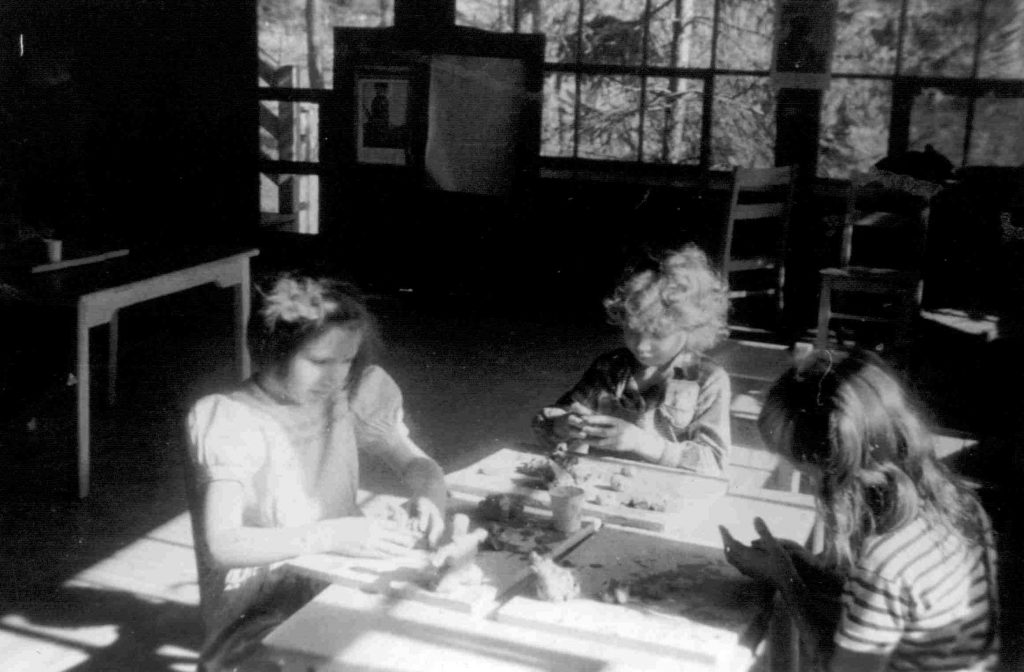History of Miquon
Our Founding
The Miquon School was founded in 1932 by two mothers, disillusioned with their own traditional educations, who discovered the Progressive education model captured better the curiosity, abilities, and potential for growth within each child. From its one-room beginnings in the old farmhouse that now serves as the office building, the school grew steadily. However Miquon intentionally remains a small school, ranging between 100 and 180 students for the past 50 years, in order to foster the close relationships that promote effective learning and teaching.
 Miquon children, circa 1930s
Miquon children, circa 1930sMiquon came through its early years by virtue of successive generations of dedicated and hard-working parents, who gave their dollars, time, and energy to the task of establishing the educational reputation and financial stability of the school. Six out of the school’s eight classroom buildings were physically built by groups of parents. Current school parents have always comprised the majority group, including the president, of Miquon’s Board of Directors. Parent participation in all aspects of school life remains a hallmark of the community.
The school’s reputation as a leader in the Progressive education movement was built over time by an extraordinary group of visionary and talented teachers. Miquon was a founding member of the Network of Progressive Educators, and continues to participate in the successor organization, Progressive Education Network. During Miquon’s 50th and 75th anniversaries, the school played host to Conferences of Progressive educators from around the country. The Miquon Math curriculum, published in the 1960s, remains popular and successful especially among home-schooling parents (though no longer used at Miquon).
Miquon has remained grounded in Progressive values throughout its history. As a result, we have grown into a school whose members prize autonomy but strive daily to work in community and harmony with one another. We are still devoted exclusively to the education and nurturing of young children, and we continue to ensure that students are able to spend time exploring our natural woods and creek.
During the McCarthy era, when some artists, politicians, and teachers were ostracized and freedom of expression was being threatened, parents and staff of Miquon took a stand against this pernicious “group think” and worked to ensure that our teachers could teach without fear of censure. Today, the importance (and fragility) of democratic values, the teaching of critical thinking, and the appreciation of different aspects of a child’s intelligence and learning styles remain central to our story. As we move towards our centenary, we continue to look for new and effective ways to prepare students to be contributors, thinkers, and creators in our rapidly changing world.
Origins of the name Miquon
The name Miquon (“Mee-kwon”) refers to the area approximately bounded by Manor Road, Barren Hill Road, and the Schuylkill River. Residents still refer to it as “Miquon,” although the Miquon Post Office and zip code were discontinued in the 1990s, and technically Miquon falls within the Borough of Conshohocken.
The origin of the name is said to derive from a meeting of Lenape people with William Penn, who demonstrated the meaning of his name by holding up a goose feather (quill pen), at which the Lenape exclaimed, “Ah … mi-quon!”
Land Acknowledgement
Miquon Upper School
The Miquon Upper School was founded by a former Miquon teacher (Arnold Greenberg) in 1970, partly in response to requests from many Miquon parents and former students who wanted the opportunity to continue their schooling in the tradition of Progressive Education.
Permission was granted to include the “Miquon” name in the title of his new school. However, the two schools were never connected or accountable to each other in any way — they had separate boards, separate administrations, and so on. They shared a name but were entirely independent of each other. It soon became apparent that the similarity of the two names was confusing to the larger community, who persisted in their belief that the schools were connected. Finally the two schools agreed that each one would benefit from having an entirely distinct identity. The Miquon Upper School changed its name to The Crefeld School as a result.